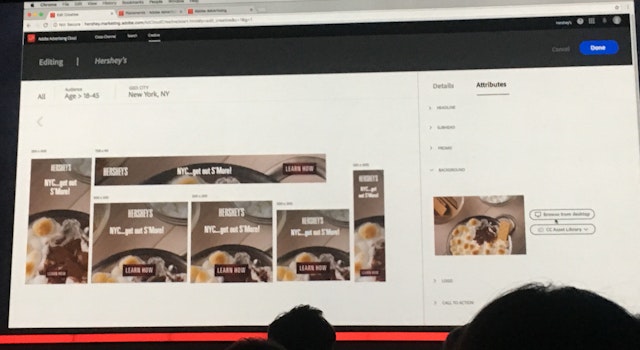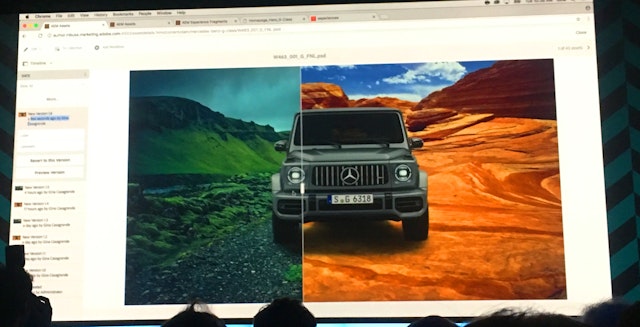Adobe’s latest integration offers brands streamlined creative planning – but will it drive them away from agencies?
A year since it launched Adobe Experience Cloud, Adobe has announced the integration of its advertising software with its most famous service – Creative Cloud. The new self-service platform will mean brands’ digital creative can be edited, adjusted and targeted in real-time without the need to pause campaigns, but this ease may be a cause for concern for traditional agencies already under threat.

Adobe sees media agencies as prime customers for its latest software launch
The news will be announced in front of brands and agencies today (27 March) at Adobe’s Summit in Las Vegas, Nevada. Simply put, the integration means users will be able to both create and deliver commercials on the same platform, which in turn means advertisers will be able to change basic design elements of creative mid-campaign, without the need to pause or pull entire media plans – a term process referred to as dynamic creative optimization.
A background may be changed from blue to green, for instance, and multiple costume choices can be executed into one campaign to target different customers programmatically. Text can also be changed; in theory, if Nike had been using the software last week, it wouldn’t have had to pull the copyright-infringing Lndr campaign entirely – it just would have needed to rewrite the end line.

Treading the line between hyperpersonalisation (currently a sore spot among consumers thanks to the Facebook/Cambridge Analytica debacle) and contextual advertising, the integration also pulls in information from Adobe Analytics Cloud, giving marketers the ability to fine-tune and optimize each ad for different audiences.
It’s a “game-changer” for Phil Duffield, managing director of advertising cloud in EMEA, and one that’s likely to have been in the planning even before the software giant acquired Tubemogul and launched Experience Cloud.
But will it pose a further threat to agencies already in peril thanks to in-housing and brands’ intrigue in consultancies? After all, the ease at which creative can be devised and deployed via Adobe gives brands yet another reason to bring in creative and programmatic in-house.
And additionally, Adobe has simplified the process of content creation further with developments in the Marketing Cloud (tools include an AI-driven auto-crop function and an easy integration with Photoshop) and the launch of Experience League, an 'enablement programme' of guided learning designed to help marketers without a high level of training to utilise the Experience Cloud.

“Will it cause [industry] fragmentation? Will it cause more in-housing of programmatic strategy and assets?” asked Duffield. “Probably. But it’s also a big opportunity for agencies, and we want to make sure they realise that.”
An opportunity for agencies
In particular, Adobe sees media agencies as prime customers for the software. It’s a sector that’s frantically looking to diversify as transparency is called into question and brands consequently pull budgets in-house. Dataxu recently reported that in five years’ time, media agencies believe their primary duties will involve operational consulting and developing creative work, rather than the usual chore of buying media.
“[Media agencies] are increasingly looking for more added value to offer their clients,” said Duffield, “and [the new platform offering] would be an incredible opportunity for them. Agencies have been under attack for a long time – they’re changing the way they want to interact with their brands and their clients and we’re providing them tools to do that."
Duffield believes that with this new software, media agencies can add another string to their bow as an intermediary between client and creative agency when one piece of creative needs to be altered or several formulations need sending out for targeting. But will that leave creative agencies with simply less work to do?
Yes, says Duffield, but that's no bad thing.
“This allows creative agencies to do their job – to be creative, to develop strategies,” he said. “What we’re allowing marketers to do is to take into their hands the ability to make changes and tweaks in real time. Or, if they want to freshen up their creative, instead of having to go to their creative agency and ask them to do so, they can do it themselves. It saves them money, saves them time to create efficiencies and gives the creative agencies time to focus on what they’re good at.”
This belief does warrant some probing. At a time when creative agencies are selling to consultancies in droves, being merged with fellow network competitors or shutting down altogether, to give them less work – however menial it may be – would surely not be kind.
But Adobe would argue the programmatic nature of the advertising and creative platform would actually lead to more work being commissioned, as four or five versions of the same ad (devised with different audiences in mind) may be needed, rather than one 30-second spot.
The platform goes live today and is already being tested in beta by companies such as MGM. Adobe as a company believes it to be a unique offering, given the proliferation of Creative Cloud (90-95% of the creative software market) and the success of Advertising Cloud so far (managing $3bn in ad spend per year). And while it draws comparison to Accenture’s work in programmatic product placement, the scale of the project is unique.
It will take another year, however, to see whether it will have a tangible effect on the brand/agency relationship.
This story will be updated throughout Adobe Summit (27-29 March).

